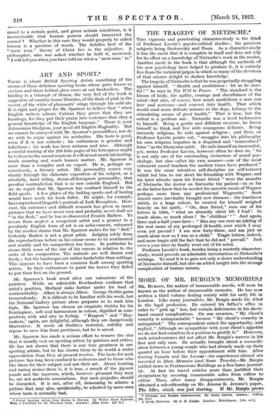ART AND SPORT.*
THERE is about British Sporting Artists something of the aroma of those delicious sporting books whose price leaves us envious and them behind glass cases at our booksellers. The binding is a triumph of fitness, the very feel of the book is suggestive of country-house libraries, of the flash of pink in the covert, of the whirr of pheasants' wings through the cold air. It is right and proper for Mr. Sparrow to believe that " when English writers admire Cubism they prove that they are humbugs, for they put their praise into sentences that obey a general knowledge of the English language." There is your Johnsonian bludgeon, your good old English illogicality. But we cannot be annoyed with Mr. Sparrow's peccadilloes, nor do we wish to argue against his aesthetics. His taste is good, even if it is not catholic ; his enthusiasm is genuine and infectious ; his work has been arduous and wise. Although a careful reading of the 239 folio pages of his letterpress might be tedious to the casual amateur, it will reveal much interesting, much amusing and much human matter. Mr. Sparrow is more than a compiler and an expert. He is, perhaps un- consciously, a literary artist. His personality comes very clearly through the elaborate exposition of his subject, as a scholarly, hard riding, damn-all-foreigners personality, that peculiar contradiction that is so rare outside England. But we do regret that Mr. Sparrow has confined himself to the field sports. A few plates of the baiting sports and of boxing would have made his book fuller. He might, for example, have reproduced Hogarth's portrait of Jack Broughton. How- ever, his extensive and difficult research has given us many pictures that we have never seen and probably never shall see " in the flesh," and he has re-discovered Francis Barlow. To rescue from neglect a competent artist and a pioneer in a peculiarly English form of art is an achievement, enhanced by the modest claims that Mr. Sparrow makes for his " find." Certainly Barlow is not a great artist. Judging solely from the reproductions before us his colour seems to be sentimental and muddy and his composition too loose. In particular he shows little sense of the size of his canvas in relation to the units of his composition. The animals are well drawn and lively ; but the landscapes are rather backcloths than settings. This appears to have been a common fault among sporting artists. In their enthusiasm to paint the horses they failed to put their feet on the ground.
Mr. Sparrow's book must alter our valuations of the painters. While an admirable Rowlandson confirms that artist's position, Morland sinks further under his load of sentimentality. Aiken is always Aiken. George Stubbs gains tremendously. It is difficult to be familiar with his work, but the National Gallery picture alone prepares us to rank him high. Mr. Sparrow has chosen an exquisite Stubbs for his frontispiece, soft and harmonious in colour, dignified in com- position, wide and airy in feeling. " Reapers " and " Hay- makers," again, are delightful, although they are dangerously illustrative. It needs all Stubbs's restraint, solidity and repose to save him from prettiness, but he is saved.
Mr. Sparrow has made a serious effort to remove the slur that is usually cast on sporting artists by painters and critics. He has not shown that there is any true greatness in our sporting artists, but he has shown them to be worth a wider appreciation than they at present' receive. The taste for such pictures has long been confined to collectors and to those who like them for their subject and not their art. About hunting and racing scenes there is, it is true, a smack of the jig-saw puzzle and the taproom, which, however pleasant they may be, are not aesthetic associations. But such prejudice should be discarded. It is not, after all, demeaning to admire a picture that may also, accidentally, be admired by some men whose taste is normally bad.
• British Sporting Artists from Barlow to Herring. By Walter Shaw Sparrow. With a YOreword by Sir Theodore Cook. London: John Lane. [52 29.1


































































 Previous page
Previous page